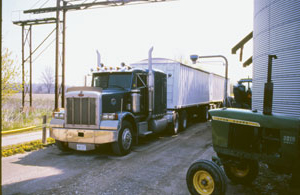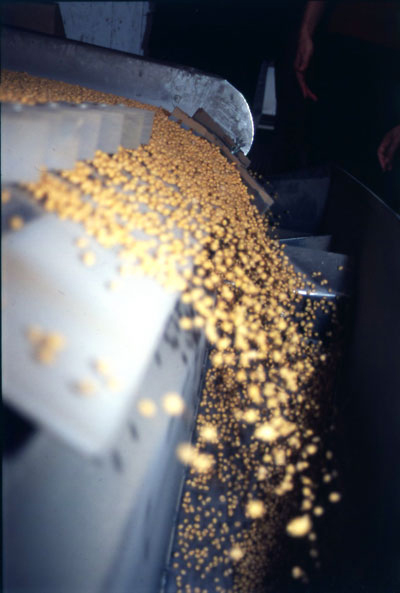
News
Low-linolenic soybeans lose ground in Ontario
Although low-linolenic soybean contracts have boomed in the United States, they have declined in Ontario.
November 30, 2009 By Heather Hager
Although low-linolenic soybean contracts have boomed in the United States, they have declined in Ontario. Fewer acres of Monsanto’s Vistive soybeans were planted in 2009 than in the first two years they were offered, despite the consistent 25-cent per bushel premium offered to grow them. “I think there were only 3000 or 4000 acres in the ground in 2009,” says Dan Wright, business development lead for Monsanto. “Originally, we had up to 10,000 acres.”
 |
|
| Trucking low-linolenic soybeans to crush facilities outside Canada reduces the profitability of any premiums. |
Low-linolenic soybean oil is targeted to the food industry as a heart-healthy oil. The decreased levels of linolenic acid increase the stability and slow the spoilage of the oil, preventing the need for hydrogenation, which can create unhealthy trans fats. Thus, the value of low-linolenic soybeans is in extracting the oil. And because soybeans are only about 20 percent oil in composition, it is much more cost effective to extract the oil locally and then ship it than it is to ship the whole soybeans. “When we launched the Vistive soybeans, we were trying to build the market and get some processors (crushing facilities) online. We guaranteed the growers a premium and viewed it as market development, to highlight the identity preservation capabilities of growers in Ontario and try to drive some of the market,” explains Wright. Unfortunately for Ontario growers, the local large crushing facilities have not yet provided segregated processing for these specialty soybeans. The soybeans must be shipped a long distance to facilities in the United States, and the added freight cost reduces the value of the premium.
Other options more profitable
Although the lack of a local crushing facility is a critical factor, it was likely not the only one that affected acres of low-linolenic soybeans in 2009, says Jim Campbell, general manager of Agris Co-operative, in Chatham, Ontario. “We don’t have any Vistive contracts for the harvest this fall. We were offering one, but growers chose not to grow them.” He thinks two other factors contributed to the decision not to grow low-linolenic soybeans.
 |
|
| The lack of a dedicated crush facility cannot overcome the wealth of heart-healthy benefits provided by low-linolenic soybeans. |
“First of all, the premiums were much higher for food-grade soybeans this year than in prior years. So, if they were an identity-preserved grower, they got a higher premium to grow food-grade soybeans. The other thing was the introduction of Genuity Roundup Ready 2 Yield soybeans. For growers that wanted a Roundup Ready soybean, the predicted yield improvement of a Roundup Ready 2 Yield, for some growers, made the economics of it surpass those of the Vistive for the 2009 harvest.” But, notes Campbell, these factors could differ from year to year.
Still, what does this mean for other specialty soybeans that are coming down the pipeline?
High-oleic, omega-3, stearidonic acid, high beta-conglycinin: these are just some of the traits that are newly introduced or are in research and development. For those traits that are oils, a local crushing facility will be key for Ontario growers to extract their full value. “It’s one thing to grow them, but if we’ve got to truck them out of the country to get them crushed, it kind-of defeats the whole purpose of growing them here,” remarks Dale Petrie, Ontario Soybean Growers (OSG) general manager. “That’s why we’d like to see a specialty crush facility right here in Ontario.” Without a local, flexible crushing facility, he also fears that the larger seed companies might be less likely to put the new genetics into short-day soybeans suitable for northern growing conditions.
An OSG and Ontario government co-funded study supported the feasibility of a crushing facility that would process 1000 to 1200 tonnes per day of seed and could switch among various crops and oils. The study was on behalf of Agris Co-operative and Suncor Energy, which markets gasoline under Sunoco and Petro-Canada brands. The two companies are looking at the synergies of establishing a facility at Suncor’s corn-ethanol plant in Sarnia, but the project has been on hold since January 2009 because of the economic downturn. Campbell estimates that even if the project were at full steam today, a functioning facility would still be about 24 months away. “We’ll be back more seriously looking at it later this fall or early in 2010,” says Campbell. “Our observations today are that the recession has affected many things, including consumer willingness to pay for some of these more premium oils that can be produced. We do believe that as the markets recover, we will go back to a segregation of heart-healthy oils and specialty segregated oils.”
Only when all the factors align successfully will this new market really be poised to get off the ground. “We’re talking about a plant that would cost in excess of $100 million to construct, so one has to be certain that the market demand and economics are good enough to manage the risk,” says Campbell. “We still believe the opportunity’s there. It’s just a matter of timing.”